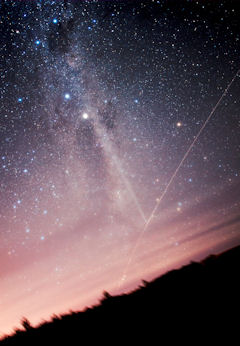
| |
Summary:
Only a few days after it left the sun, Comet Lovejoy
showed up in the morning skies of the southern hemisphere. Observers
in Australia, South America, and New Zealand likened it to a search
light beaming up from the east before dawn. [more] |
|
 |
| |
| |
Photographer,
Location |
Images |
Comments |
|

|
Wayne
England,
Poocher Swamp west of Bordertown, South Australia
Dec. 25, 2011 |
#1,
#2, #3,
#4, more |
When
I arrived at my location there was quite a lot of lightning
on the eastern horizon which gave a nice glow in the images.
The night was so still so I was able to get some nice reflections
in the water. Nikon D7000, Tokina 12-24mm lens at 12mm.
60sec, ISO 3200, f4. |
|

|
JIA
HAO,
Yorkrakine Rock, Western Australia
Dec. 25, 2011 |
#1
|
To
the love and joy of all astromers, here's the best Christmas
gift for us from comet Lovejoy! It now shines the eastern
sky of southern hemisphere with a tail of up to 30 degs
long! No matter where and how you watch it, with your family
after Christmas party, or like me driving 200km to a dark
site to get the full out of it, you will surely be LOVEJOYED!
|
|

|
Scott
Alder,
Senic Lookout, Newcastle NSW Australia
Dec. 24, 2011 |
#1
|
Here
is my Comet Lovejoy image it was taken on 24 dec. 2011 at
4:15 am It is 43x6 second exposures at ISO1600. 50mm f1.8
lens. Canon EOS 600D. camera was on a fixed tripod. Image
taken from Senic Lookout, Newcastle. Some cloud was on the
horizon but otherwise fairly clear. |
|

|
Mauricio,
Santiago Of Chile and atacama Desert
Dec. 23, 2011 |
#1 |
none |
|

|
John
Drummond,
Patutahi, Gisborne, New Zealand
Dec. 28, 2011 |
#1,
more |
As
I was imaging Comet Lovejoy this morning (2011 Dec 28 14:30hrs
UT) the International Space Station graced itself through
the sky and kissed the face of Lovejoy. Canon 500D DSLR,
20mm Canon lens at f2.8, 1 x 6 minute exposure @ 1600 ISO.
|
|

|
Carlos
Caccia,
Intendente Alvear. La Pampa. Argentina
Dec. 24, 2011 |
#1 |
Transit
of ISS on the tail of Comet C/2011 W3 LOVEJOY. Luck gave
us the best view from which I keep to the ISS. With magnitude
-8.5 appeared from ORION. Then already 390Km on Int Alvear
followed to "stick" to the Cross. And down parallel to the
via Lactea arrived at the tail of Lovejoy and with its typical
golden color. (data from Heavens Above) 1 photo. 134sec.
F/5 ISO 800. Nikon D90 18mm. 24/12/2011. 4:22 Hrs |
|

|
Grant
Bisset,
Hawea, New Zealand
Dec. 25, 2011 |
#1 |
Comet
Lovejoy and Crux photographed from Hawea NZ at 03:41NZDT.
Canon 5D 35mm lens ISO1600 20 secs. |
|

|
Emilio
Lepeley,
Vicuna, Chile.
Dec. 24, 2011 |
#1
|
Comet
Lovejoy is getting better!, with a tail over than 30 degrees
and still bright, easily visible with the naked eyes. |
 |
more
images: of Comet Lovejoy
|
|
|
 |



